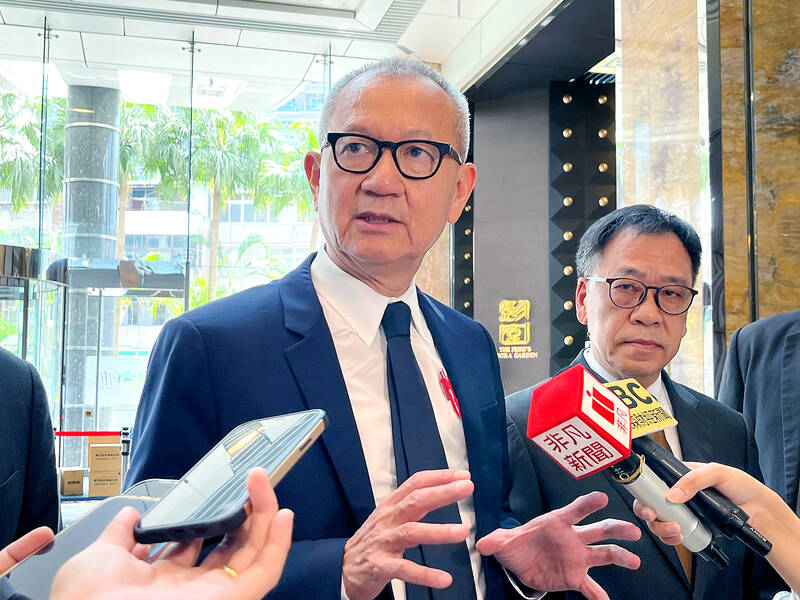Yageo Corp (國巨), the world’s third-largest supplier of multilayer ceramic capacitors, yesterday forecast its second-quarter revenue to stabilize, snapping a three-quarter losing streak.
Consolidated revenue last month was flat at NT$9 billion (US$293 million), compared with the previous month, but declined 14.5 percent from a year earlier, the company said.
Cumulative revenue in the first five months dipped 13.2 percent year-on-year to NT$44.11 billion, as customers scaled back orders amid inventory digestion, it said.

Photo: CNA
It would take at least two quarters for the passive-components sector to work through an excessive inventory of standard parts, it said.
Nevertheless, Yageo said it was better equipped than its peers to weather the inventory correction cycle, given that it supplies premium passive components used in vehicles, and industrial and medical devices.
“From our perspective, the market is likely to recover gradually like an L shape, rather than as a V-shape rebound,” Yageo chairman Pierre Chen (陳泰銘) told reporters on Tuesday following the company’s annual general meeting in Taipei.
As Yageo has been diversifying its product lineups to niche and high-end products, the company would be able to sustain growth, Chen said.
Through mergers, acquisitions and product adjustments, the company has expanded its high-end product revenue contribution to about 80 percent, he said.
Among premium products, passive components used in vehicles registered slight revenue growth, helping the segment’s revenue contribution exceed its 20 percent share target in the first quarter of this year, Chen said.
“We have broken into the first-tier automakers of Japan,” he said.
A decline in passive components used in consumer electronics was also a factor, he added.
The company also sees the industrial, medical and aerospace sectors as key growth areas, he said.
Yageo has tapped into sensor businesses through merger-and-acquisition deals with Heraeus Holding GmbH and Schneider Electric SE, he said.
Those sensors are used in industrial devices and vehicles, he said.
Heraeus Nexensos makes premium platinum thin-film temperature sensors for high-precision measurements, and has operated for more than 100 years in the high-end industrial and automotive segments.
In aerospace, Yageo’s revenue has grown several-fold through its subsidies Kemet Corp and Pulse Electronics Corp, Chen said.
Yageo said its passive components are also used in artificial intelligence (AI) devices such as AI servers from Quanta Computer Inc (廣達) and Wistron Corp (緯創).
“We will not be absent from the AI industry,” Chen said.
Yageo’s components are used in a wide range of electronics and it works with customers in designing new products such as 6G-enabled devices and low Earth orbit satellites, it said.

Nvidia Corp chief executive officer Jensen Huang (黃仁勳) on Monday introduced the company’s latest supercomputer platform, featuring six new chips made by Taiwan Semiconductor Manufacturing Co (TSMC, 台積電), saying that it is now “in full production.” “If Vera Rubin is going to be in time for this year, it must be in production by now, and so, today I can tell you that Vera Rubin is in full production,” Huang said during his keynote speech at CES in Las Vegas. The rollout of six concurrent chips for Vera Rubin — the company’s next-generation artificial intelligence (AI) computing platform — marks a strategic

REVENUE PERFORMANCE: Cloud and network products, and electronic components saw strong increases, while smart consumer electronics and computing products fell Hon Hai Precision Industry Co (鴻海精密) yesterday posted 26.51 percent quarterly growth in revenue for last quarter to NT$2.6 trillion (US$82.44 billion), the strongest on record for the period and above expectations, but the company forecast a slight revenue dip this quarter due to seasonal factors. On an annual basis, revenue last quarter grew 22.07 percent, the company said. Analysts on average estimated about NT$2.4 trillion increase. Hon Hai, which assembles servers for Nvidia Corp and iPhones for Apple Inc, is expanding its capacity in the US, adding artificial intelligence (AI) server production in Wisconsin and Texas, where it operates established campuses. This

US President Donald Trump on Friday blocked US photonics firm HieFo Corp’s US$3 million acquisition of assets in New Jersey-based aerospace and defense specialist Emcore Corp, citing national security and China-related concerns. In an order released by the White House, Trump said HieFo was “controlled by a citizen of the People’s Republic of China” and that its 2024 acquisition of Emcore’s businesses led the US president to believe that it might “take action that threatens to impair the national security of the United States.” The order did not name the person or detail Trump’s concerns. “The Transaction is hereby prohibited,”

Garment maker Makalot Industrial Co (聚陽) yesterday reported lower-than-expected fourth-quarter revenue of NT$7.93 billion (US$251.44 million), down 9.48 percent from NT$8.76 billion a year earlier. On a quarterly basis, revenue fell 10.83 percent from NT$8.89 billion, company data showed. The figure was also lower than market expectations of NT$8.05 billion, according to data compiled by Yuanta Securities Investment and Consulting Co (元大投顧), which had projected NT$8.22 billion. Makalot’s revenue this quarter would likely increase by a mid-teens percentage as the industry is entering its high season, Yuanta said. Overall, Makalot’s revenue last year totaled NT$34.43 billion, down 3.08 percent from its record NT$35.52